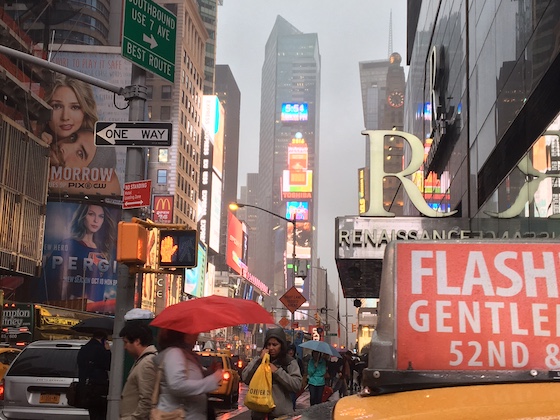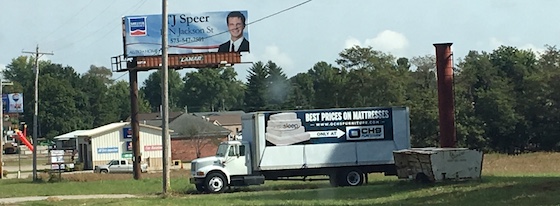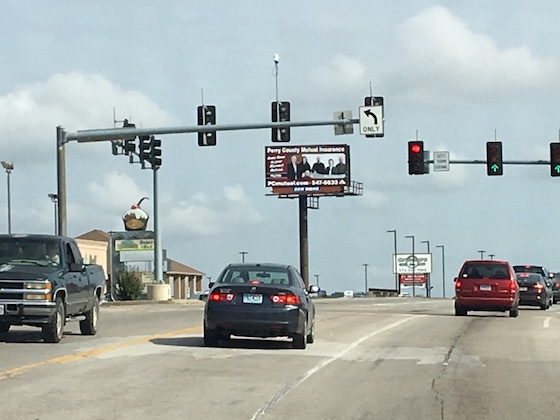Memo From Frank
In about 30 days, all those political billboards will come down. The election will be over and regardless of who wins, nobody will need political billboard advertising for another two to four years. And that moment will create an overnight huge spike in billboard vacancy. That’s why I’ve never been a big fan of political ads. They are short term and no matter how good a job you do, there’s no renewal. I’ve never seen any stats on how effective these billboards are, but I have noticed that there appears to be a correlation between winning an election and ad spending. That’s what makes the lack of renewal so unfair – shouldn’t the winner award the sign company with an extra term of thanks? Maybe a six-month “thank you to all my voters” ad? Unfortunately, that’s not the way political billboards work. So if you have some, get ready for a strong sales effort.
A Primer On Selecting Billboard Lighting Plans

So you’re building a billboard and need to decide what to do for illumination. How do you begin the process of determining the power and number of lights on the sign? Well, there’s a methodology to it that improves your odds of making the right decision.
What is the normal standard on this stretch of road?
Begin with an analysis of what everyone else is doing. Literally chart out how many light fixtures the next five signs up and down from your location are using, on both sides of the highway. This will give you a rough estimation of the competition. Remember that most advertisers are going to grade your sign on a curve – your brightness will be compared to those signs around you to see if you are as bright. If your sign appears weaker in illumination, expect trouble renting it and retaining customers.
What is the ambient light surrounding the sign?
Another issue is how much light there is around your sign. For example, if your sign is out in the country in a dark farm field, you do not need as much brightness to stand out as if it’s in the city and competing with street lights and premise signs.
What is the setback from the road?
A sign that is farther off the roadbed will require more illumination. In some cases, having brighter lights than the other signs is the only benefit that a sign that is extremely distant can offer. Your cell phone looks bright at night in front of your face, but if you lean it against a tree and step back 50 feet, it’s not bright at all. Make that adjustment.
What are the budget limitations?
Lights come in all shapes, sizes and price points. How much do you have to spend? If the budget is unlimited, than you can never really be too bright (just like you can never be too rich or too thin). But for most sign builders, there are budgetary constraints that will force you to try to and simply keep up with the Joneses (the surrounding signs) and not try to get too fancy.
Don’t forget what Benjamin Franklin said
Benjamin Franklin once said “it’s not the price of the fireplace, but the price of the firewood that’s important”. He’s right. If you add lights that are of a greater watt intensity, you will feel that with your monthly power bills. Do you want to pay $50 per month or $150 per month? So be sure to find out the expected monthly power costs of the light fixtures you are contemplating. You may decide that the 250 watt units are a better buy than the 400 watt when the monthly power cost is compared.
Conclusion
The worst way to select lighting for a billboard is to simply use the same thing on every sign. Every billboard’s lighting needs are different, and should be considered before ever ordering the fixtures.
Alternative Uses For Used Billboard Vinyl

This is a scene in Quebec, Canada where outdoor billboard vinyl has been used to construct “lampshades” on city street lights. In fact, there are a number of uses for billboard vinyl that enterprising sign companies have adopted over the years. At one point, you could buy purses made from the material, and many farmers use them as tarps or to patch roofs on barns. One group sells used billboard vinyl for interior decoration. It really is a very strong and adaptive material. Got any ideas?
Billboard Home Study Course
![]() How to Find a Billboard Location
How to Find a Billboard Location
![]() How to Buy a Billboard
How to Buy a Billboard
![]() How to Build a Billboard
How to Build a Billboard
![]() How to Operate a Billboard
How to Operate a Billboard
![]() How to Rent Ad Space on a Billboard
How to Rent Ad Space on a Billboard
![]() How to Sell a Billboard
How to Sell a Billboard
Get Your Copy Now!
How Times Square Became The Nation’s Biggest Billboard Epicenter

Times Square is the most visited place in the world with over 360,000 pedestrian visitors a day, amounting to over 131 million a year. It has a greater attendance than do each of the Disney theme parks worldwide, with 128,794,000 visitors per year, versus 126,479,000 for Walt Disney World attractions. Even excluding residents from the visitor count, Times Square is the world's second most visited tourist attraction, behind the Las Vegas Strip. The high level of pedestrian traffic has resulted in $4.8 billion in annual retail and entertainment sales, with 22 cents out of every dollar spent by visitors in New York City being spent within the Times Square area. Because of this exposure, billboard advertising grew significantly, beginning in the 1920s. Billboard revenue went from $25 million per year in 1920 to $85 million by 1930. For example, the Wrigley Spearmint Gum sign, possibly the biggest electric sign "in the world," cost $9,000 per month to rent in the 1920s. Today, the billboards in Times Square are the most expensive in the world. But there’s good reason for that. More people see those billboards than any other signs in the world.
Why Illegal Signs Are Not That Good Of A Business Model

Here’s a photo that shows two completely different business models. One is a legal, permitted monopole billboard. The other is an illegal sign that is just a vinyl tied to a truck. So which business model is superior? In my opinion, the legal sign is always the way to go, and for good reasons.
Risk of operational disruption
Illegal signs have not right to be there. As a result, they are subject to removal at any time – typically once the city or state inspector gets a hold of you. This kind of systemic shock is not attractive to most people. With a legal sign, the worst case scenario would be storm damage and that danger is maybe once or twice a year. With illegal signs, the chance of total destruction is 24/7 and that creates a huge amount of stress.
Potential liability
And if you get caught and have to remove your sign, there is more to worry about than just the shock of having to do so. You might also get sued by the advertiser, claiming that you warranted the sign was legal and that they have a lengthy contract. Or you might get sued by the city of state, most of which have penalties that can run up to $1,000 per day. While these are rarely levied if you obey and remove your sign immediately, it’s still something to worry about.
Lack of liquidity and loss of value
It’s basically impossible to sell an illegal sign to anyone. As part of their due diligence, most buyers are going to demand proof of the permit and, if you don’t have a permit, the deal is dead. And that’s not to mention the fact that no bank will make a loan on an illegal sign, either. So you’ve basically built something that is completely illiquid. Now compare that to the opportunity cost if you had only built a legal sign. That sign might sell for 5 to 10 times the net income and any bank would finance it. That’s quite a letdown if you have spent your life building illegal signs.
Bad precedent and future impact
I once built an illegal sign in southern Dallas. I knew better. I just thought I’d get away with it. I might have except that a competitor called the city inspector on me (which is typically what happens). I agreeably removed the sign, but the damage was done with the inspector’s relationship with me. From that point on, the inspector would give me no slack on any permit application I made, as they perceived me as “that guy who doesn’t follow the rules”. And the really bad news is that inspectors don’t change jobs much, so you’re stuck with them for years.
Moral issues
And, of course, there’s also the morality issues with doing illegal things. While I will not dwell on these ethical considerations, I would point out that it is something to consider. I may speed while driving, but most everything else is above-board. Building a business model around doing illegal things constantly may cause some people anxiety and low self-esteem.
Conclusion
You are always better off building a legal sign than an illegal one. Even if you have not moral qualms about it, it’s still better from a dollars and cents perspective. John Dillinger made good money for a brief while, but he ended up in prison and dead. Same with Al Capone. The legal route is far superior.
In Praise Of “Head-On” Billboards

Probably the most valuable billboards on earth are those that appear “head-on” to on-coming traffic. Created by a curve in the road, you cannot miss these signs as they appear to be right in the middle of the freeway. They typically rent for far higher amounts than standard signs. So how can you get one of those?
Watch for such locations
Whenever a road curves, there is the potential for a “head-on” sign. So watch for this. Look at which property has the most severe case of visibility. Many people don’t realize the power of the curve over the straightaway, and will fail to understand or target this desirable spot.
Be willing to pay a little extra
“Head-on” signs will rent for more money, so you can pay a little extra ground rent on them. If you were thinking $100 per month on a regular sign on that road, you could maybe stretch to $200 for the “head-on” sign. The billboard I built in Denton, Texas is a perfect example. It is one of the landmark signs of Denton, and you can literally see it in the middle of I-35 from a mile back. I pre-sold the advertising space to Coors for five years at three times more than the other signs in the city. I paid the property owner a premium of 50% more than the surrounding signs (which was $500 per month). So I paid an extra $250 per month, but took in an extra $1,500 per month in revenue. That’s a good deal.
Get creative if necessary
With a “head-on” sign, all of the money is in the one side that is visually right in the middle of the road. So, if necessary, get creative. If the property owner wants more than money, you could literally give them the opposite side of the sign for free and the numbers still probably work out.
Use a “V” when needed
To harness the full power of these type of locations, you may want to build a large “V”, which will angle the sign fact more severely to the road and extend the length of read. Do it. Again, you will have a greater initial cost, but you’ll make that back many times over in higher ad rents.
Conclusion
“Head-on” signs are extremely valuable and profitable. Target those and try to make them happen, These are the type of signs that become true landmarks and stay occupied continuously.
The Market Report
Prices Are Delayed By At Least 15 Minutes
